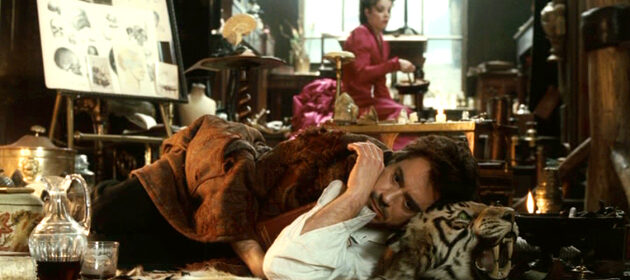Sarah Greenwood

AS: Working with Guy Ritchie and Joe Wright –are those guys very visual?
SG: Do you know something -they’re polar opposites. They both have a fantastic kind of vision. I would say Joe is very visual and working with him is a real treat. But equally Guy is very visual and very appreciative of what you give him.
Guy had never done period. You say to him, Don’t worry about that, let’s do the story. The actual practicalities of the visual will come. The authenticity had to be absolutely as spot-on as we could make it to allow that madness to come within it.
On this Sherlock we’ve done a ball like in an old Hollywood movie of the Forties. A ball with a hundred and fifty extras and amazing ball gowns and uniforms. Then you put in Holmes and Watson dancing together and that’s what makes it funny. It wouldn’t be funny if the ball was comic in any other way. So as mad as launching the ship in the first one was when you read it on the page -you just felt, Well, that will get cut! and of course it didn’t!- as mad as that was, it had to be completely real and potentially believable. We didn’t want to do the Jules Verne version, it had to not be fantasy. The story was fantastic but it couldn’t be fantasy. So in that sense it was great, the very extreme, contrasting environments that you have with Sherlock. Whereas working with Joe is much more cerebral and atmospheric and intellectual I suppose. So I love working with both.
AS: Did you work closely with visual effects? Like with the bridge sequence on Sherlock Holmes?
SG: Yes, that was very interesting for me because I hadn’t done big CG movies before and didn’t know a whole lot about it. Chas Jarrett was the effects supervisor and he was fantastic to work with. He demystifies it, for a start. What I particularly liked about the first Sherlock was your set extensions. It means the camera can move much more fluidly within a period location. So we do as much as we can and as the camera moves across it you sort of glimpse London beyond. All of that works amazingly.
Where I don’t think it works fantastically is where some of the camera moves became not possible, you know what I mean? There’s one shot from the bridge where Rachel McAdams comes to the top of the bridge and it’s a helicopter shot basically -it just distances you from what you’re seeing. I just wonder if there weren’t other ways of taking you less out of the process.
But that said, it was a fantastic way of working. We create a library for him of buildings and research and did lots of visuals of what old London should look like. And then they go out and photograph it and put it together. There’s always places where you think, That’s too extreme, you don’t need to go that big and wide, but that’s just my personal taste. And Joel Silver and Guy want it really big and that’s what they got. But interestingly for a lot of the critics that was one comment they had, that some CGI went a bit too extreme. That is what the producers wanted as opposed to what Chas and I necessarily would have said. But it’s very exciting to have that technology and not be scared of it.
Pingback: Laurence Bennett